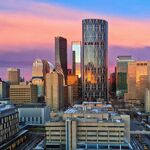trtcttc
Senior Member
I don't really think population or opiod crisis should factor in, since provinces adapt to what their demographics are like. Cancer rates are higher in AB, rural/urban population split may be different, younger population means spending more in other areas, etc. The difference in days isn't that significant for the 50th percentile, since those are usually the more urgent cases.A little over 20% of BC population is age 65+ vs a little under 15% in Alberta. BC is harder hit by the opiod crisis, too. Yet they are beating us pretty strongly in all of the serious surgery categories at the bottom.
And while that migration data is encouraging, I'd caution that the bulk of those numbers are likely residents or docs who recently finished residency. It would be interesting to dissect it in more detail YOY, but there's quite a bit of randomness how residency matching plays out overall - some years you have more fresh grads match out of their desired province than others, and 2 to ~7 years later they'll tend to return to their home province.
You'd need to delve into multiple years of data to make any conclusions, while also looking at residency positions filled. For instance, in 2019 UBC filled 344/347 residency spots, second in both total and % only to U of T (407/407). The implication being lots of docs wanted to do do residencies there, but not all will remain there to practice.
I'm not suggesting any causal relationships between any of these groups, but I'd point out that the maritimes have more dramatic swings with much lower populations. There is likely a relationship between having more (and more in demand) residency positions compared to number of med school graduates (which doesn't guarantee home province of student, but probably a higher correlation than residency)
PROV NET MIGRATION 2024 RES SPOTS FILLED VS GRADUATES 2019
MAN -26 124%
SASK +24. 115%
QUE +95 99.9%
ONT -207 122%
NL +46 97%
NS +113 *Dalhousie not broken down by province
NB -84 *Dalhousie not broken down by province
AB +76 117%
BC -34 122%
That's all a bit convoluted, but you see places with comparatively fewer/lower demand residency spots in 2019 seeing a positive net migration in 2024. So my supposition would be that Toronto, Vancouver, and even Winnipeg have higher levels of out-of-province residents, who generally end up returning home to practice. To be fair this idea should also apply to Halifax, but the opposite seems to be true out there.
But hopefully we are also just convincing more residents to stay.
Migration data also fluctuate year over year, I didn't mean to suggest we are doing much better than BC at attracting doctors, simply that we are not having a mass exodus of doctors that the media sometimes suggests. And not every residency spot is equal. Some specialties are extremely limited, so someone may go train in Dalhousie, because they couldn't get into to UBC but fully intend to move post-graduation. Some may end up moving, or some people find good professional connections/personal reasons, end up staying some place. With the small sample size, hard to find causal effects.





